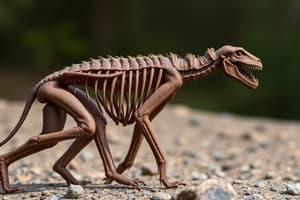Podcast
Questions and Answers
Who were the two individuals who independently conceived the theory of evolution by natural selection?
Who were the two individuals who independently conceived the theory of evolution by natural selection?
Charles Darwin and Alfred Russel Wallace
What are the four observable facts about living organisms that establish evolution by natural selection?
What are the four observable facts about living organisms that establish evolution by natural selection?
(1) More offspring are often produced than can possibly survive, (2) Traits vary among individuals with respect to their morphology, physiology, and behaviour, (3) Different traits confer different rates of survival and reproduction (differential fitness), (4) Traits can be passed from generation to generation (heritability of fitness)
What is the basis for heredity in modern evolutionary theory?
What is the basis for heredity in modern evolutionary theory?
DNA molecules that pass information from generation to generation
What are the processes that change DNA in a population?
What are the processes that change DNA in a population?
What is the last universal common ancestor (LUCA)?
What is the last universal common ancestor (LUCA)?
How have existing patterns of biodiversity been shaped?
How have existing patterns of biodiversity been shaped?
What is the phenotype and genotype of an organism?
What is the phenotype and genotype of an organism?
What is the modern evolutionary synthesis definition of evolution?
What is the modern evolutionary synthesis definition of evolution?
What are mutations and why are they important for genetic variation?
What are mutations and why are they important for genetic variation?
How are new genes generated from ancestral genes?
How are new genes generated from ancestral genes?
How does sex and recombination contribute to genetic variation and evolution?
How does sex and recombination contribute to genetic variation and evolution?
Which process of evolution is responsible for the loss of species throughout the evolutionary history of life on Earth?
Which process of evolution is responsible for the loss of species throughout the evolutionary history of life on Earth?
What is the term for the complete set of genes within an organism's genome?
What is the term for the complete set of genes within an organism's genome?
What is the term for the specific location of a DNA sequence within a chromosome?
What is the term for the specific location of a DNA sequence within a chromosome?
What is the term for the different forms of a DNA sequence at a locus?
What is the term for the different forms of a DNA sequence at a locus?
Which of the following is NOT a source of genetic variation in organisms?
Which of the following is NOT a source of genetic variation in organisms?
What is the ultimate source of genetic variation in all organisms?
What is the ultimate source of genetic variation in all organisms?
What is the process by which new genes can be generated from ancestral genes?
What is the process by which new genes can be generated from ancestral genes?
What is the role of sex in increasing genetic variation and evolution?
What is the role of sex in increasing genetic variation and evolution?
Which two individuals independently conceived the theory of evolution by natural selection?
Which two individuals independently conceived the theory of evolution by natural selection?
What are the four observable facts about living organisms that establish evolution by natural selection?
What are the four observable facts about living organisms that establish evolution by natural selection?
What is the basis for heredity in modern evolutionary theory?
What is the basis for heredity in modern evolutionary theory?
Flashcards are hidden until you start studying




